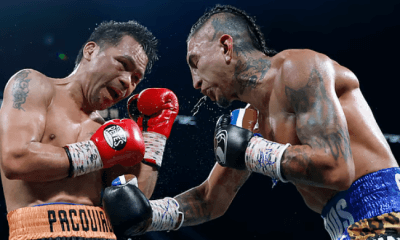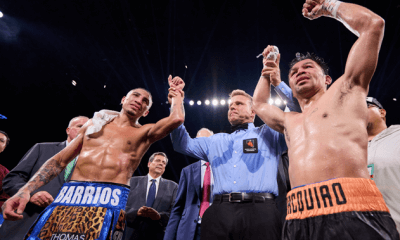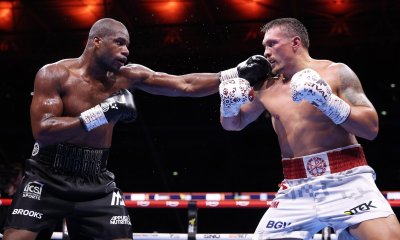Articles of 2005
Boxing in Monticello, Bet on It
Monticello, New York – Gone are the days when boxing and horse racing ranked with baseball as the three major sports in the United States. Gone are the days when upstate New York was the locale any fighter worth his title belt went for training camp.
Gone is any trace of Mike Tyson from this region.
The glory days may never return but there is a comeback underway. Not Tyson, perhaps, but boxing is back in the Catskills.
Like most boxing comebacks, money is at the root. But not the kind of money you might expect. The people at the famous Monticello harness racing track played host to the first professional fight card at the venue since it opened on June 27, 1958. The good folks at Monticello have also opened the Mighty M gaming hall, replete with poker and slot machines on the first floor.
When you think casino, you automatically begin to think big money. Then you think high rollers. Then you think boxing, because the only thing a high roller loves more than a straight flush is a ringside seat to a good scrap. Thus, while officials at the Mighty M are waiting for New York State Governor George Pataki to sign legislation that will allow them to function as a full casino, they are getting a jump on the fight game.
Enter New York City P.R. man Jules Feiler, whose connections in boxing run deep. The Mighty M brought him on board because they have grand visions for their casino and the sport of boxing. To this end, Feiler arranged for a bus to leave New York City that would ferry media types up to the inaugural boxing event.
Enter promoters Bob Duffy and Tony Mazzarella, of New York-based Ring promotions. They staged a rock-em, sock-em six-bout card on Friday, October 7. The Catskills and boxing have shared a long, rich history. Resorts like Grossingers, Kutschers, and The Concorde played host to the training camps of such legends as Joe Louis, Rocky Marciano, Floyd Patterson and countless others. Then, in the early 1980s, Tyson emerged from Cus D’Amato’s Catskill Gym to rule the heavyweight division.
“If this goes well we're talking about doing a couple of more shows,” said Mazzarella. “The whole history of the Catskills, the venue itself, the challenge of doing a fight in a place like this, it's important to us.”
As you walk into Monticello’s first fight card, the first thing you notice are actually the betting windows. Monticello simulcasts races from all over the country and, alas, while waiting on line to enter the fights, you can play the late double out at Santa Anita or any other live West Coast track card.
Monticello is to harness racing what Saratoga is to the flats. This is a resort town track. As such, they need to appeal to a large cross-section of people. That lends itself to a wide variety of promotions. This is boxing, so naturally, you need something other than the fight to promote.
Enter six-time world champion and Hall-of-Famer Emile Griffith. Griffith used to hold training camp in the Catskills so this isn’t his first visit to the track. It is the first time, however, that a race has been held in his honor. The night before the fights, Monticello dedicated the 12th race to Griffith. The race was won by Fox Valley Wannabe, driven by Billy Parker Jr. It paid $6.60 and covered the half-mile in 2:01.4. I asked Emile if he was able to get some money down. He shook his head and laughed. But he did pose with horse in the winner’s circle after the race.
Griffith, on hand to sign autographs on fight night, is the angle for this show. But there will be no shortage of ideas because Feiler is working with Monticello’s long-time P.R. man John Manzi. Mike Katz once wrote about the late fight trainer and manager Paddy Flood, “He had more angles than a geometry professor.” Manzi, a harness driver who won about 130 races before retiring to work publicity, would do Flood proud. He has raced elephants, camels and even humans against horses. He’s done this all in the name of getting publicity for Monticello Raceway. (In the interest of entertainment, I will sprinkle some Manzi moments throughout the text.)
* * *
1981, Beasley vs. The Beast. Manzi pits New York Giants defensive back, Beasley Reece, the self-proclaimed fastest man in the NFL, against Super Kris, the losingest racehorse in the world. The colt entered the showdown having lost 125 straight races and the record remained in tact after losing to Reece. (Wink) Manzi has the photo finish hanging on his office wall. Word has it that it only took one take to get the shot right.
* * *
The ring is situated between the betting windows and the grandstand that overlooks the half-mile oval track. The room is set up to accommodate 900 fans. Over 800 show up. I make my way back to the dressing rooms and I find Kevin Rooney, one of the last remaining links to the glory days of the Catskills. He is working with local middleweight prospect Lenord Pierre, who meets 45-year-old former welterweight champion Manning Galloway in the main event.
“I think it's a good starting point,” says Rooney, who trained Tyson and continues to work with fighters out of D’Amato’s Catskill gym. “I remember driving down to spar with Roberto Duran when he had his training camp at the Concorde for the first Leonard fight. The Catskills has a long history in boxing. This can be the perfect spot to do club shows. Then maybe you build from that. Maybe you get an ESPN card in here and who knows what can happen? The game needs something. Why not here?”
* * *
1980, Leonard-Duran I. Monticello owns exclusive rights for the closed circuit broadcast of the first Sugar Ray Leonard-Roberto Duran fight. It was the only place between Manhattan and Albany that someone could watch the fight. They pulled down the big screen and drew a record 17,495. At least, that was the official attendance. “We charged $2.50 to get in,” said Manzi. “We counted 17,495 that night. I was screaming like a lunatic, ‘don't close the gates.’ But they closed the gates. They were climbing the fences and walking in through the track.”
* * *
On this night, the fighting at Monticello is as real as it gets. This is what a club show is all about. Great fights. Minimal purses. Loud crowd.
The opener lasts 25 seconds as William Jeter knocks out Terry Peacock. My seat at the press table happens to be next to the alternate referee. When ref Pete Santiago descends the ring he tells me that was the quickest knockout he’s worked in well over 100 fights.
The next four bouts are outstanding. It’s a tribute to matchmakers Duffy and Pete Brodsky and to the fighters. These young gladiators compete in earnest, vying for that step up to the next level. The physical price they pay seems not to matter. The four-round middleweight fight between Jose Rodriguez (1-0) and Kenny Johnson (1-2) is a non-stop punchfest. It ends when referee Benji Esteves halts things at 1:57 of the fourth. Johnson, who fought gamely throughout, had taken enough punishment and finishes dazed, but on his feet. When Esteves returned to his seat at the table, I ask him what he takes into consideration before stopping a fight, especially as one as exciting as Rodriguez-Johnson.
“I try to find out as much information about the fighter as I can,” he said. “Is he a stronger finisher? Does he fade late in fights? How does he recover? Sometimes, you can’t find that out. In this fight, I saved him to fight another day. He’s young. He’ll fight again. I thought he was behind. I didn’t think he had a chance to win.”
Adam Czachor desperately wanted to win his four-round junior welterweight fight against Samuel Lopez. Czachor, you see, hasn’t won in two previous attempts. He seemed on the way to a win when a nasty cut opened alongside his left eye. It was the result of an accidental butt. Nonetheless, it changed Czachor’s approach. To make matters worse, he was also cut alongside the bridge of his nose, near his right eye. The injuries slowed him in the 2nd and 3rd rounds far more than Lopez’ punches. Rather than fold, he fought his heart out in the fourth and final round and forced a draw. His ledger now reads, 0-2-1. Lopez is 1-1-1
Throughout the card, ring announcer Joe Antonacci reminds the patrons that a live music act is playing downstairs in the Lava Lounge. It is not so much the music he’s touting, but a chance to allow fight fans to wander through the gaming floor and perhaps make an investment.
Speaking of music …
* * *
1971. The same year he beat Muhammad Ali in their first fight, Joe Frazier and his group, the Knockouts perform at Monticello. “They were more loud than good,” recalled Manzi. “But nobody complained. Who was going to complain to Joe Frazier?”
* * *
Lumpia Rashim wins a split decision over Juan Carlos Sanchez in a four-round welterweight bout. It was Rashim’s pro debut and the first loss for Sanchez (2-1-1). Jonathon Tubbs (7-0-1) and Gilberto Guevera (3-0-1) both remain unbeaten when their six-rounder ends in a draw. The proof that the matchmaking was excellent comes in the form of two draws and a split decision. Despite the great action, the loudest cheer of the night comes when Antonacci announces that the Red Sox have been eliminated from the playoffs.
On to the main event. Galloway took the fight on a week’s notice for $3,500. He once held the WBO welterweight title, he’s headlined cards all over the world and at 45 he owns a successful landscaping business. But he can’t quite get boxing out of his system.
Pierre, at 26, is 19 years younger than his opponent. Galloway, at 62-18-1, has more career losses than Pierre, 17-1, has wins. Pierre figures to walk right through him. Not quite.
The southpaw Galloway is awkward and a bit herky-jerky. Pierre can’t figure him out. They grab a lot, they fight in close quarters and they are tossing bombs. Galloway is wobbled in the opening round, but he’s too smart to allow Pierre to finish the job. He’ll never get the chance. After what Estevez ruled an accidental head butt, the fight ends as a No Decision in the fourth round after Galloway sustains a long gash alongside his left eyelid. According to New York State rules, four rounds must be complete for a decision to be rendered. At the time of the stoppage, Galloway leads on all cards.
But, he does not protest the stoppage. “I’m in the other guy’s hometown,” he said. “Look, if it goes into the sixth round and then they stop it, who knows, now maybe I don’t get the decision. Now it goes into the records as the doctor stopped the fight.”
The crowd is a bit letdown, confused perhaps, over the stoppage. Most of them were on hand to see the local product vanquish the out-of-towner. Nonetheless, no one was complaining. Particularly the people calling the shots at Mighty M.
“I think this is a rousing success,” said Tom Aro, CEO of Mighty M Management. “We're looking to do this on a regular basis. I think the community will support it.”
They probably won’t even need an angle. But in case they do …
* * *
1999, Battle of the Hunting Lodges. There are numerous hunting lodges in the area so Manzi allows representatives from local lodges to sit in the driver’s seat and race the horses. They wear antlers on their helmets and everyone gets a good laugh.
* * *
“Thank God no one ever got hurt,” said Manzi, when thinking back to those races. “Maybe I’ll bring that one back.”
Why not? They’ve already brought back boxing.
-

 Featured Articles3 weeks ago
Featured Articles3 weeks agoThe Hauser Report: Zayas-Garcia, Pacquiao, Usyk, and the NYSAC
-

 Featured Articles2 weeks ago
Featured Articles2 weeks agoOscar Duarte and Regis Prograis Prevail on an Action-Packed Fight Card in Chicago
-

 Featured Articles2 weeks ago
Featured Articles2 weeks agoThe Hauser Report: Cinematic and Literary Notes
-

 Book Review6 days ago
Book Review6 days agoMark Kriegel’s New Book About Mike Tyson is a Must-Read
-

 Featured Articles4 weeks ago
Featured Articles4 weeks agoManny Pacquiao and Mario Barrios Fight to a Draw; Fundora stops Tim Tszyu
-

 Featured Articles4 weeks ago
Featured Articles4 weeks agoArne’s Almanac: Pacquiao-Barrios Redux
-

 Featured Articles3 weeks ago
Featured Articles3 weeks agoRemembering Dwight Muhammad Qawi (1953-2025) and his Triumphant Return to Prison
-

 Featured Articles4 weeks ago
Featured Articles4 weeks agoOleksandr Usyk Continues to Amaze; KOs Daniel Dubois in 5 One-Sided Rounds














